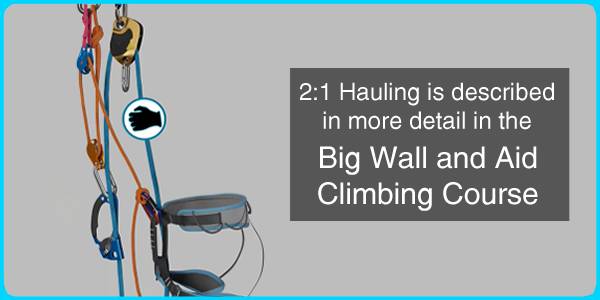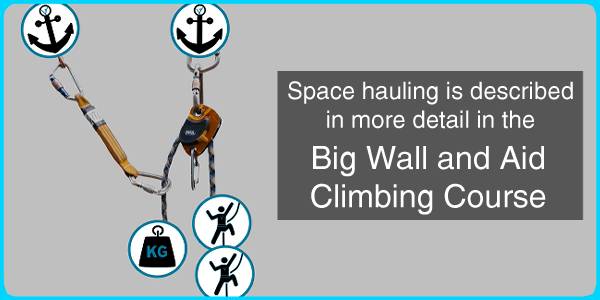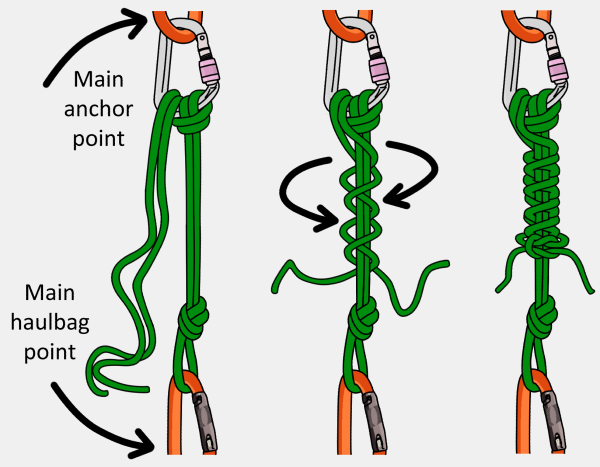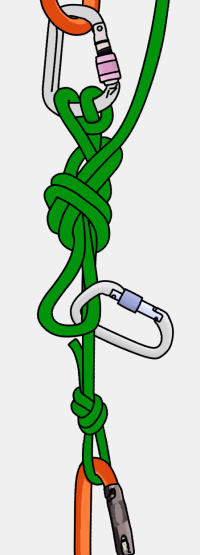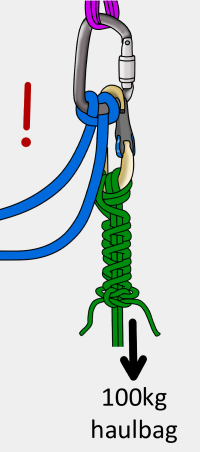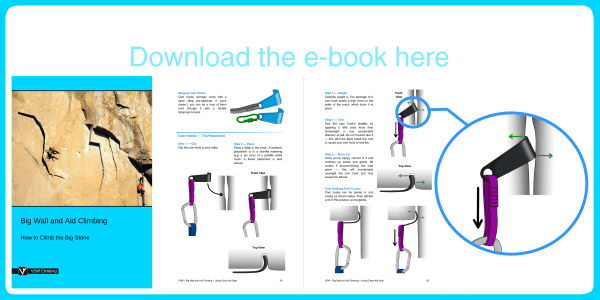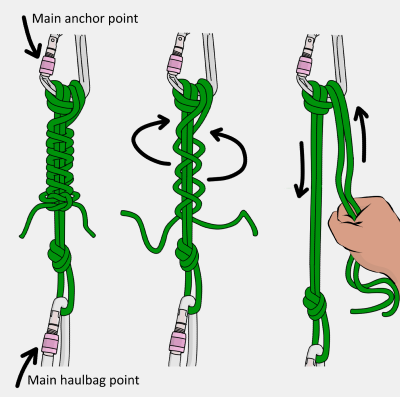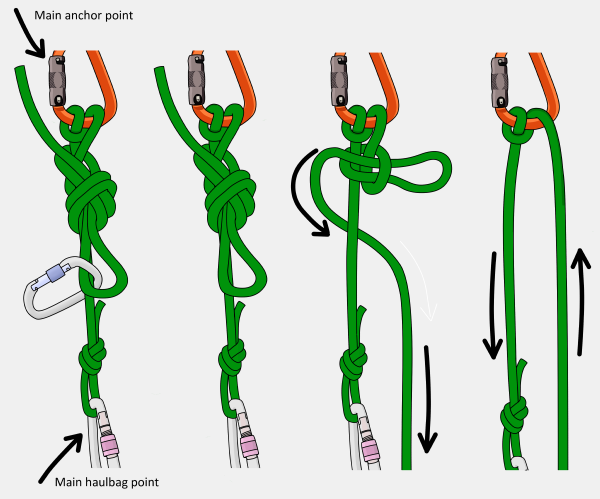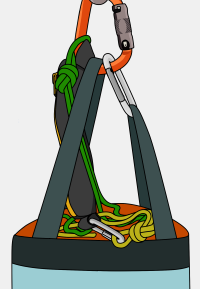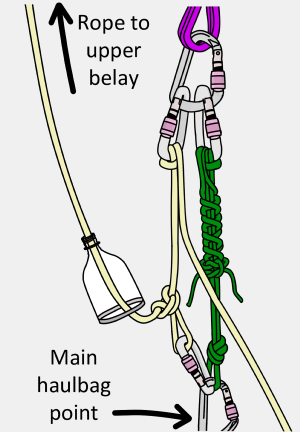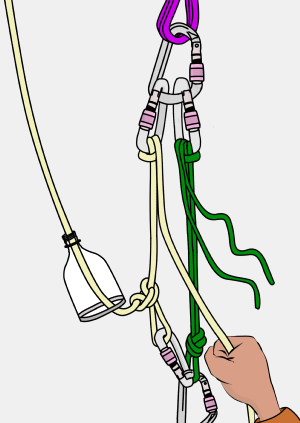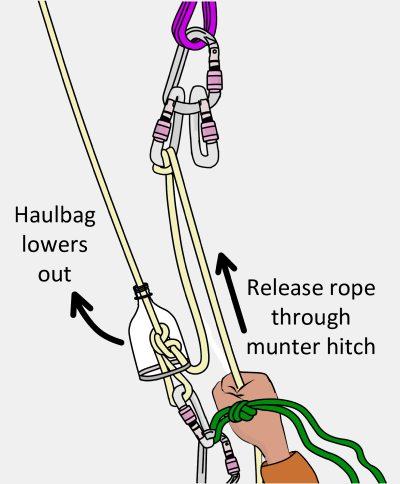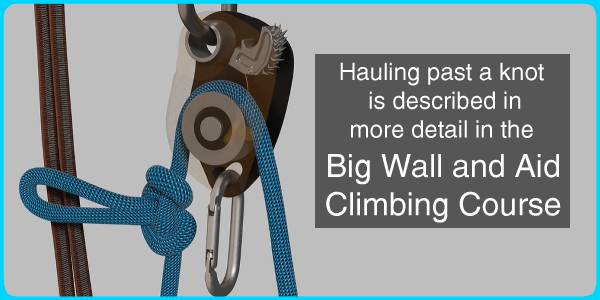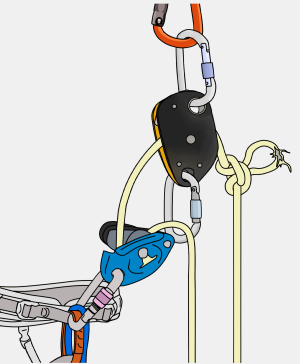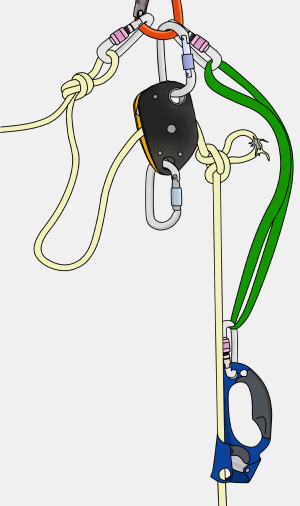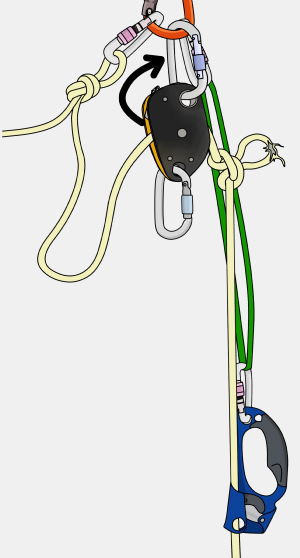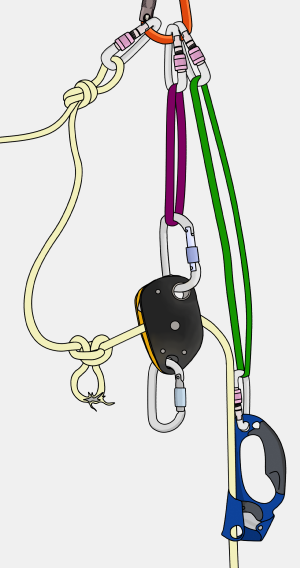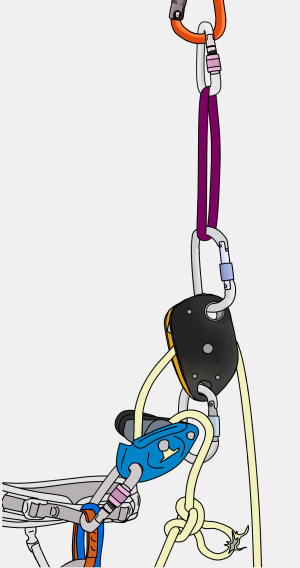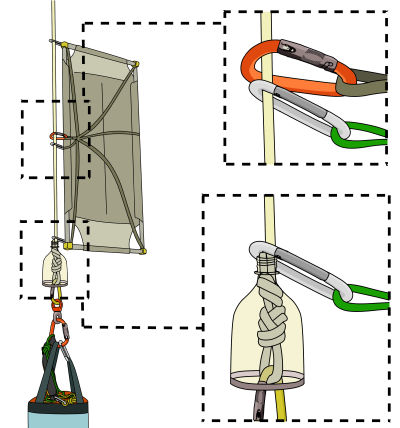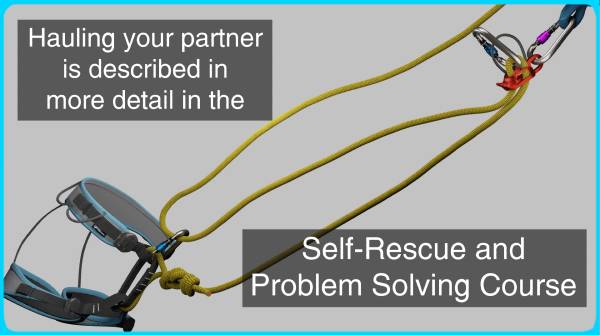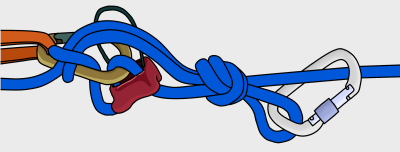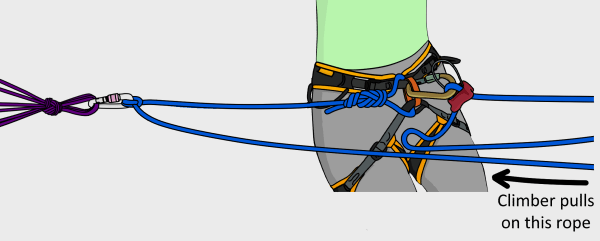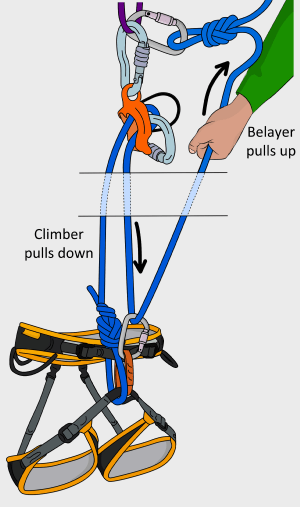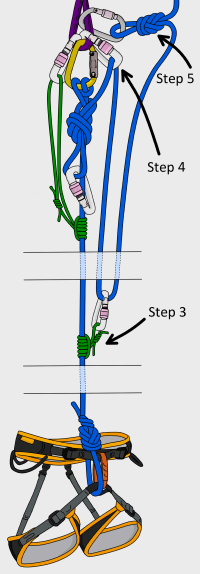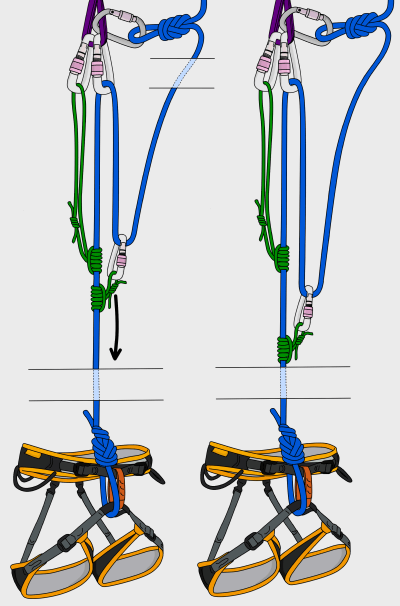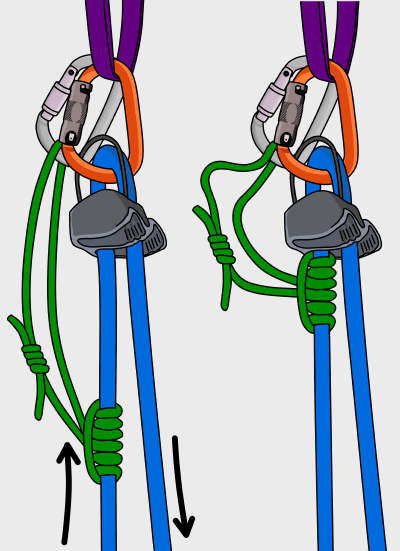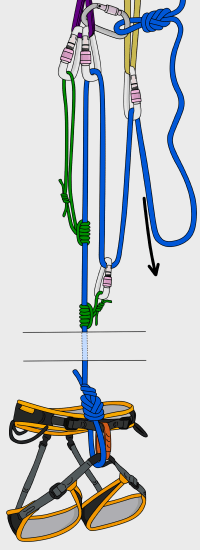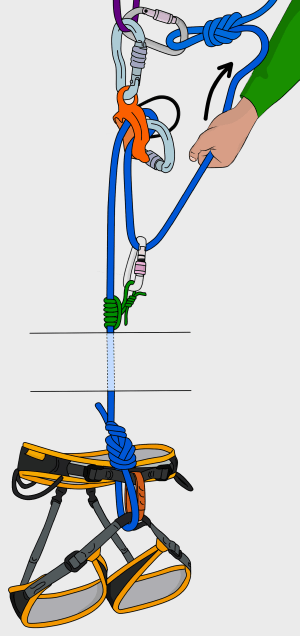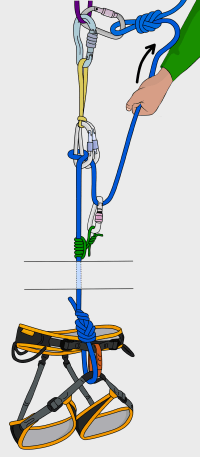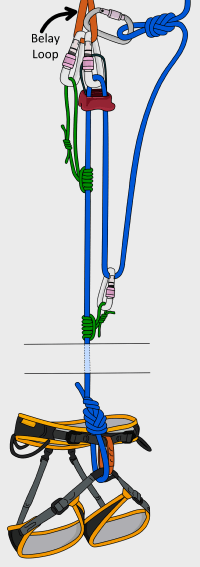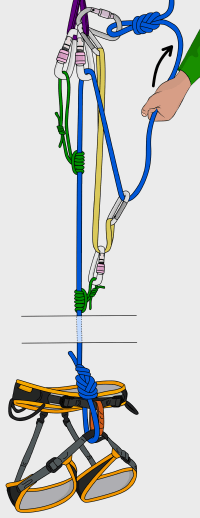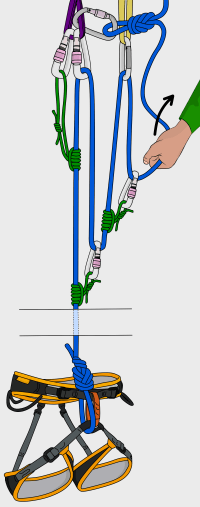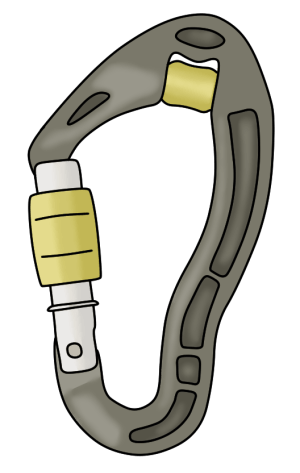Check out the full big wall video course, or download the e-book.
There are different hauling systems you can use to get your equipment up the wall.
1:1 hauling is the simplest and most suitable for light loads. A 2:1 or 3:1 setup may be needed for heavy loads or hauling up slabby terrain. Space hauling can be used with any system to speed up the haul too.
It is easy to switch between systems once they are set up (e.g: You might start with a 3:1, and then switch to 1:1 space hauling once your partner has finished cleaning the pitch). All of these systems are described in detail in this chapter.
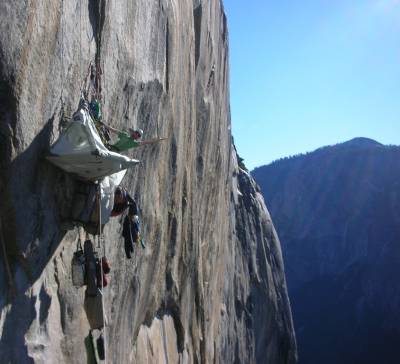
Backing Up the Haul
Auto-locking hauling devices are very unlikely to break. The most likely cause of failure is the toothed catch becoming wedged open, causing the haulbag to plummet. This usually happens because something got stuck in it or there was a weighted rope pinching it into the rock.
Prevent this disaster by keeping the hauling device clear of anything else at the belay and add a back-up during the haul. With a 1:1 or a 3:1, this back-up will be your GriGri. With a 2:1, the back-up will be the cord. Neither of these are textbook ways to back something up – for added security, tie the haul line to the belay occasionally. If you need to remove a back-up, make sure to add another first (e.g: If switching from a 1:1 to a 2:1, attach yourself to the 2:1 before removing your GriGri).
Pulley Orientation
Hauling devices and pulleys should be used with compatible carabiners (ovals work best). This spreads the load evenly across the bearings.
Using an ill-fitting carabiner causes a sideways strain on the pulley and makes hauling even harder.
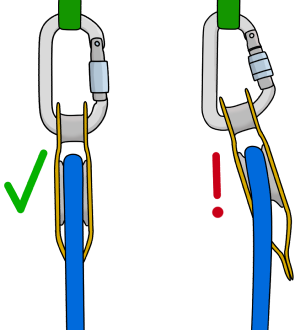
Friction
On slabby terrain, the haulbag will drag up the wall, creating friction which makes the hauling more difficult. The same is true for blocky terrain where the tensioned haul rope rubs over rock features. The more the haulbag and rope contact the rock, the more friction is created and therefore the harder the hauling will be. The same weight hauled 1:1 on overhanging terrain may need a 2:1 on slabby terrain.
Some belays are conveniently situated above a nice ledge. This provides a great stance, but often creates unwanted friction when the haul rope rubs over the lip of the ledge. It is worth setting up the haul at the side of the ledge so this doesn’t happen, if the opportunity exists to do so.
Mechanical Advantage
The hauling systems in this section are described using their mechanical advantage. Adding mechanical advantage makes the hauling slower, but easier. Imagine you had to carry 75kg of equipment in a backpack along a trail (like when you are walking to the base of the route). Would you carry all 75kg in a single monster load (1:1)? Or would you split the load into 3 and carry a more manageable 25kg each time (3:1)?
With a 3:1 setup, three meters of rope must be hauled to move the load up one meter. This means you must haul three times the distance of the pitch. In theory, a 3:1 is three times easier than a 1:1. In reality, it’s more like 2.5 times easier. This difference between theoretical and actual mechanical advantage is primarily due to friction around pulleys and stretch in the rope.
Taking this lack of efficiency into consideration, it is still definitely worth adding mechanical advantage to a 1:1 if you’re finding it extremely difficult to haul. Which setup you use depends on the weight of the haulbag and the friction involved. Try a 1:1 first and go from there. It’s easy to switch between systems mid-haul if needed.
Hauling Systems – 1:1
A 1:1 is the foundation upon which all other hauling systems are built. Regardless of your chosen system, you will need to set this up first anyway.
Advantages
- Simple
- Requires little equipment
- Often the quickest way of hauling
Disadvantages
- Very difficult to haul more than your own bodyweight
Most suitable for:
- Light loads (less than your bodyweight) when the hauling is steep
You will need:
- a hauling device (e.g: Petzl Pro Traxion)
- an auto-locking belay device (e.g: Petzl GriGri)
Note
The leader’s tie-in knot has been removed from the following diagrams for clarity.
Step 1
After leading a pitch, attach yourself to the anchor, fix the lead rope and set up the hauling system.
Step 2
At this point, your belayer will release the haulbag.
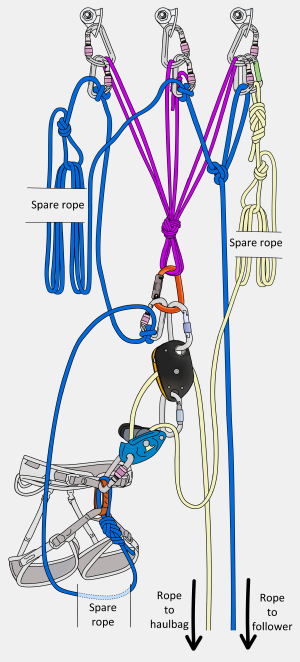
Step 3
Now the hard work begins. Lean your weight back onto your GriGri so it locks, and push out and down from the wall. The lighter your bags, the easier this will be. Pulling on the ‘up’ rope with one hand will give you a little extra help. If your bags are super heavy, you could try bracing your feet against the wall at head-height and pushing out using your legs.
Step 4
Once you have pulled some rope through the hauling device, step into your aiders and 'reset' by pulling the slack rope through your GriGri, as if you are taking in a top rope. With practise, you will develop a smooth hauling action, keeping your feet in the same position throughout the haul.
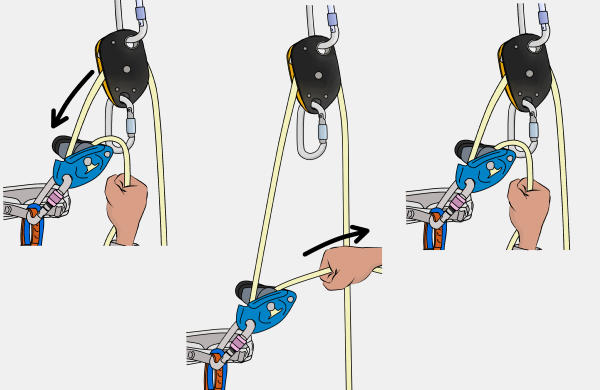
Step 5
Stack the rope away neatly as you haul so that it won’t tangle into the hauling device. Stop hauling when you still have around 30cm of rope left – be careful not to jam the knot into the device.
Step 6
To complete the haul, you will need to dock the bag.
Top Tip
Pace yourself. Have a rest every 20 or so pulls and stack the rope or have a sip of water. Treat it like a marathon, not a sprint.
Hauling Systems – 2:1
Advantages
- It’s much easier to haul the same weight on a 2:1 than a 1:1
- Enables you to haul more than your own bodyweight
- You can add or remove the 2:1 setup from a slack or tensioned haul rope, meaning it’s easy to switch between systems mid-haul
Disadvantages
- Requires more pulleys than a 1:1
- Must haul twice as much rope as a 1:1
Most suitable for
- Heavy loads (a little more than your bodyweight)
- Hauling light loads up high-friction terrain
You will need:
- a hauling device (e.g: Petzl Pro Traxion)
- an auto-locking belay device (e.g: Petzl GriGri)
- two non-locking pulleys
- a jumar (or similar)
- a 2 meter length of 8mm nylon cord (don’t use dyneema cord – this material weakens with repeated flexing and will suddenly snap mid-haul)
Step 1
Set up the cord, pulleys and jumar as shown. If you don’t need the pulleys for anything else, it is worth leaving this set up for the duration of the climb.
- 8mm cord permanently tied through pulley. This allows the pulley to twist itself into position when hauling.
- Clovehitch tied on two carabiners. This knot is easy to unfasten after being loaded – just wiggle the carabiners to loosen it.
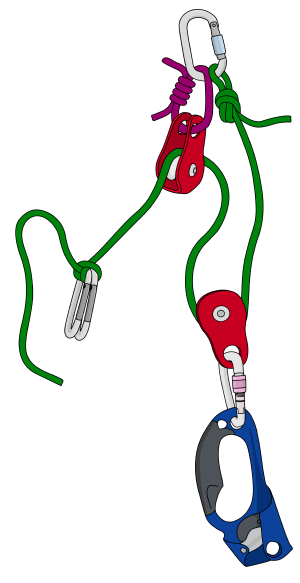
Step 2
Attach the 2:1 to the 1:1 as shown, either to the bottom hole of your hauling device (if there is one) or to the main anchor point. Whichever you choose, it’s important to orientate it so the haul rope and cord can move freely without rubbing against each other or anything else.
Step 3
Clip the double carabiners to your belay loop and adjust the clovehitch to a comfortable length.
Step 4
Lean back in your harness to haul with the cord while simultaneously pulling slack haul rope through the hauling device.
Step 5
To reset the system, stand up and slide the jumar down the rope.
Fine-Tune
The 2:1 can be fairly clumsy at first. Adjust the clovehitch and try standing in different steps of your aiders until you fine-tune the position which allows you to haul with a smooth rhythmic action. This system is very efficient once you get used to it.
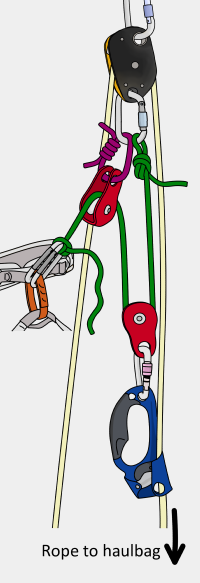
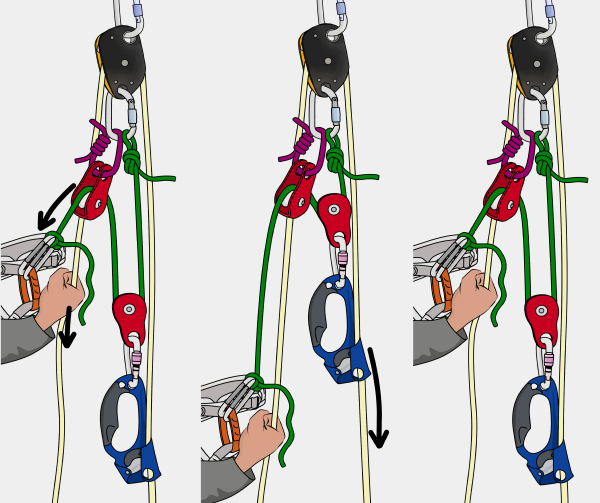
Hauling Systems – 3:1
Advantages
- Even easier to haul than a 2:1
- You can add or remove the 3:1 setup from a slack or tensioned haul rope, meaning it’s easy to switch between systems mid-haul
Disadvantages
- Requires more pulleys than a 1:1
- Must haul three times as much rope as a 1:1
- Resetting the system can be awkward depending on the terrain
Most suitable for
- Monster loads (twice your bodyweight)
You will need:
- a hauling device (e.g: Petzl Pro Traxion)
- an auto-locking belay device (e.g: Petzl GriGri)
- a small locking pulley
- a non-locking pulley
- a jumar (or similar)
Step 1
Set up the pulleys and jumar as shown. You can set the lower jumar and pulley as far down as you have rope available. Wiggle the rope to move the jumar and pulley further down beyond your reach, making sure they remain orientated correctly.
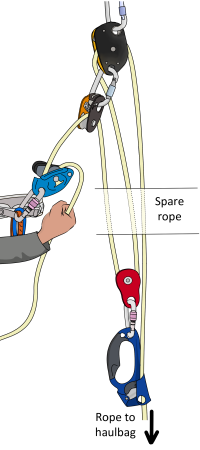
Top Tip
A carabiner clipped to the jumar as shown helps it glide down the rope more smoothly – useful when setting it out of reach.
Step 2
Haul in the same way as a 1:1. Depending on how far down you set the jumar, it may take a couple of pulls to get the stretch out of the rope before the haulbag actually moves up.
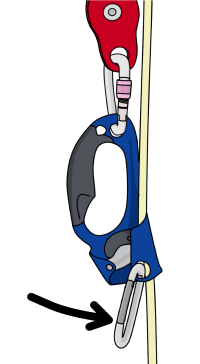
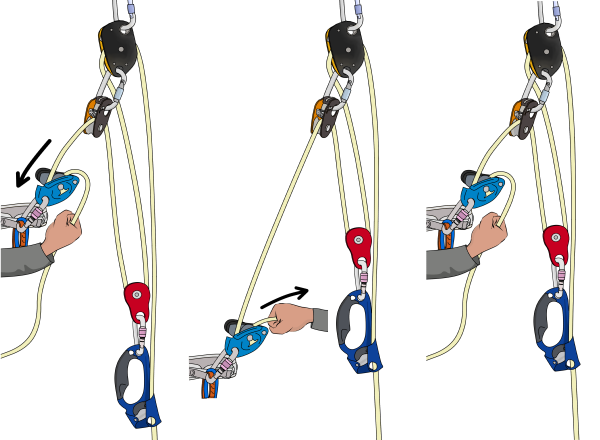
Step 3
When the lower pulley gets close to the small locking pulley, flip the catch on it to release the locking mechanism. The main hauling pulley will now take the weight – check that the catch on the main hauling pulley is correctly engaged before moving onto the next step.
Step 4
Pull slack through your GriGri and push the jumar down the tensioned rope.
Step 5
Once you have pushed it as far as you can reach, flip the catch back down on the small locking pulley and continuing hauling.
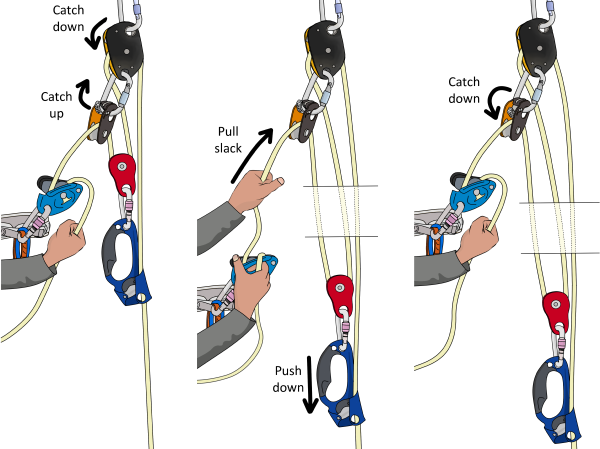
Space Hauling
Space hauling means using your partner as a counterweight to assist with the haul. It can be used with any mechanical advantage system, and doubles the efficiency (e.g: Two people hauling with a 3:1 setup gives a 6:1 advantage).
Advantages
- Because the hard work is shared, the hauling is easier and faster than the other methods
- For most of the haul, the lower climber will be within reach of the haulbag. This means they can guide it around features and prevent it from getting stuck
Disadvantages
- Must wait until your partner has cleaned some, or all, of the pitch
- Can be difficult on overhanging terrain – the lower climber will have to jumar a free-hanging rope
Most suitable for
- Loads which are too difficult to move on your own
- Hauling up fixed ropes on less than vertical terrain
How To Space Haul
The lower climber weights the haul rope while the top climber hauls. It is VERY IMPORTANT that the lower climber stays backed-up on the lead rope while they do this. This back-up will need to be adjusted as the haul progresses. The lower climber will move down while the upper climber hauls. The lower climber will, at some point, need to jumar back up the rope. To streamline this process, they can ascend the rope at the same time as the upper climber hauls.
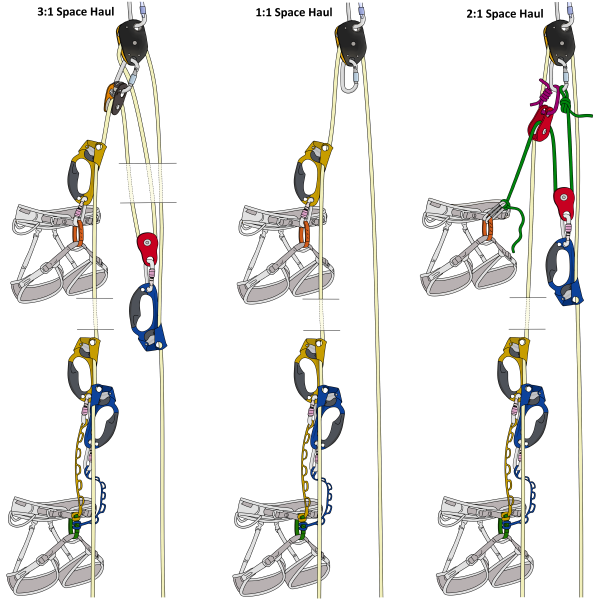
Space Hauling Tips
- There will often be a part of the pitch which is easier for the lower climber to jumar up (e.g: a lower-angle section). Once at this point, they can ‘jumar on the spot’ while the other climber hauls. This also means there is no need for the lower climber to keep adjusting their lead rope back-up.
- Space hauling while wearing all the rack you just cleaned from the pitch is difficult. It is often better to finish cleaning the pitch and deposit the rack at the belay before you help with the haul.
